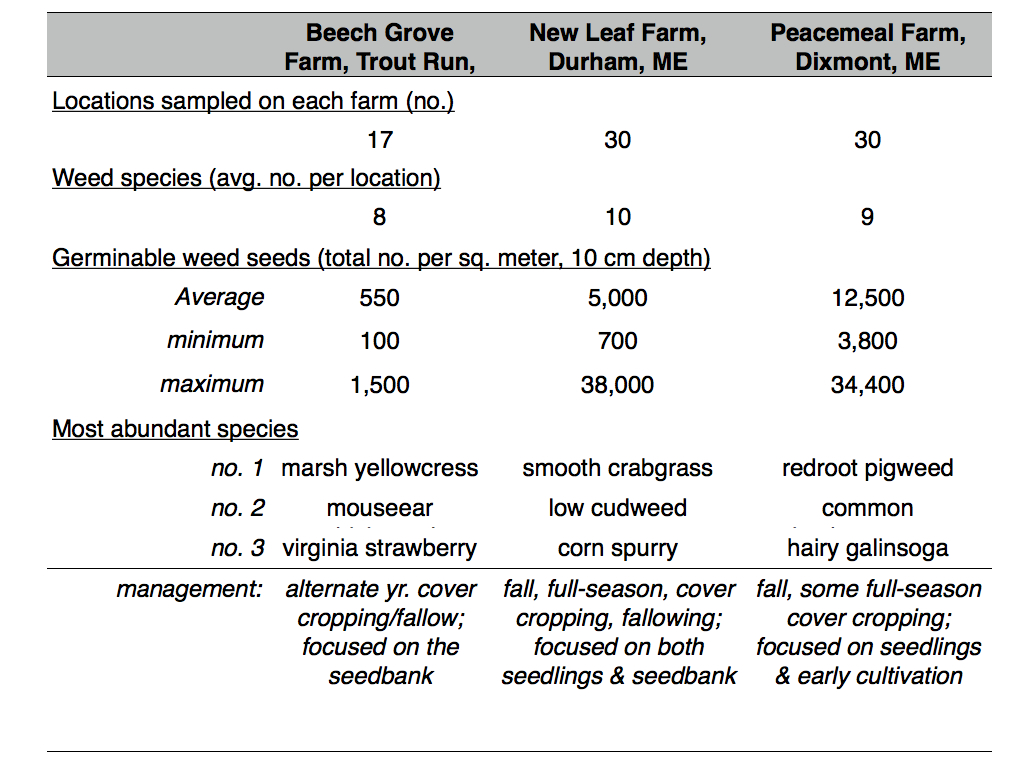Weed Seedbanks: 2009 On-farm Sampling
Seedbanks
“Credits” to the weed seedbank occur when weeds shed seed, i.e., seed rain, and “debits” when seeds are removed from the soil by germination, predation, or decay/death, in this declining order of importance.
Seedbanks on the Beech Grove, New Leaf and Peacemeal Farms
During the 2009 field season we visited Eric and Anne Nordell of the Beech Grove Farm in Trout Run, PA, Dave and Christine Colson of New Leaf Farm in Durham, ME, and Mark Guzzie and Marcia Ferry of Peacemeal Farm in Dixmont, ME, to collect soil samples from selected fields. At each sampled location on each farm we collected ten soil cores (6.5 cm diam. x 10 cm deep) from a 25 square meter area. Soil samples were sieved to remove stones and spread over a layer of vermiculite and placed in a greenhouse. Weed seedlings were identified, recorded and removed weekly. The soil was allowed to dry and was then mixed and replaced in the flats once a month for four months.
Weed communities were comprised of an average 8 to 10 species on each farm (see Table, below). The three most abundant species at the Peacemeal Farm are troublesome in most vegetable crops and are a widespread problem among northeastern vegetable growers. At the New Leaf Farm, smooth crabgrass was the top-ranked species, primarily because of a large infestation in a field where pigs had been pastured. Low cudweed and corn spurry, while a problem in salad mix, are not particularly troublesome in most other vegetable crops. At the Beech Grove Farm, typically pernicious summer annual weeds were rare and not among the top ranked species.

Typical samples are shown below. These photos were taken after approximately 4 weeks in the greenhouse. They offer a visual representation of the “low,” “medium,” and “high” seedbanks measured on these farms.

Seedbank Management
Managing weeds with a focus on the seedbank looks at the farming system with an eye first towards opportunities for preempting seed rain with short-season cash or cover crops that are harvested or terminated before troublesome weed species produce mature seeds. Next, opportunities for shallow soil disturbance, strategically-timed to be coincident with weed species-specific peak emergence potential, will encourage germination. Subsequent disturbance events can kill these “flushes” of weeds. When seed rain occurs, opportunities for predation are greater if seeds remain on the soil surface. This hypothesis, that fall tillage should be delayed to encourage seed predation is the focus of current field studies.
For more information see:
Managing weeds with crop rotation
http://www.newenglandvfc.org/pdf_proceedings/2009/MWWCR.pdf
and these eXtension articles:
Manage the Weed Seed Bank—Minimize “Deposits” and Maximize “Withdrawals”
http://www.extension.org/article/18527
Manipulating Weed Seed Banks to Promote their Decline
http://www.extension.org/article/18528


